The first of these interviews is with the multiple award-winning (Eisner, Harvey, Spectrum, Inkpot, and Haxtur) author/illustrator Mark Schultz.
Schultz, who has been described by many to be "one of the nice guys in Comics," has managed to tackle nearly every character we comic book and movie fans only dream of working with: Aliens, Conan, The Flash, The Terminator, King Kong, Luke Skywalker, Prince Valiant, Superman, Tarzan, and Tyrannosaurus rex to name just a few. However, he's best known for the lavishly-illustrated Xenozoic Tales, an action-adventure series featuring old world mechanic Jack "Cadillac" Tenrec and the bold, beautiful Hannah Dundee. Of course, there's more than a few classic cars and dinosaurs thrown in for fun.
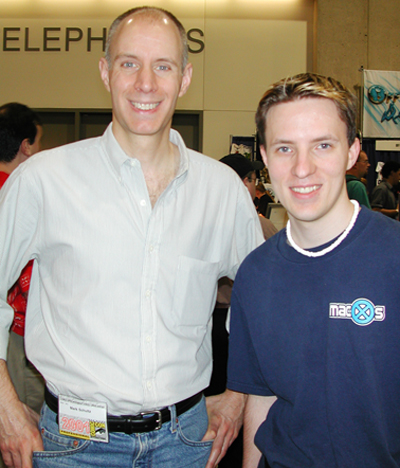
Mark Schultz and myself at the 2001 San Diego Comic-Con.
--
DDM: First of all, thanks for taking the time to chat. I know a lot of people are anxious to hear what you’ve been up to and what exciting projects you have on the horizon but let's start with your own creation, Xenozoic Tales. I know it means a great deal to you, and readers are anxious to find out what's going on with the series.
Q: As the creator of Xenozoic Tales, (later re-branded as Cadillacs and Dinosaurs for Epic Comics and the animated television show from Nelvana), you’ve not only written but illustrated most of the series yourself. How did the idea come about?
Schultz: Through long hours of career dissatisfaction while I was executing advertising illustrations and working as a security guard. I’d long dreamed of becoming a cartoonist and spent a good deal of time imagining what my ideal comic book would be, based on my love for Edgar Rice Burroughs, EC Comics, King Kong, and other adventure movies and stories. Those influences, mixed with my interest in man’s relationship with the natural environment gelled into what became Xenozoic Tales. Essentially, I was creating the type of comic adventure I wanted to read, but wasn’t available in the contemporary market.
Q: In reading Xenozoic Tales, we seem to discover a slyly disguised ‘message’ at its core about the Earth and the symbiotic relationships of the planet’s systems. Not many comics or graphic novels can get away with this, yet you seem to have pulled it off effortlessly. The time period inhabited by your characters is a direct result of their ancestors’ effects on the Earth. Did you start with that message and find a story or was it the reverse?
Schultz: These concerns are very important to me, but even more important is telling a good story. If I feel that I am being preached to while I am reading a story, well, the storyteller has lost me. I trust that’s the same for my readers. The message, if there is one, must be integrated and buried within the dramatic telling of the story or it will alienate any reader who isn’t already on board with the point of view being promoted. In the case of Xenozoic Tales, the environmental angle was actually one of the last ingredients that got mixed into what started as pure SF adventure, but it was the necessary element that, I think, elevated the series, and, at the very least, keeps me interested in creating new stories.
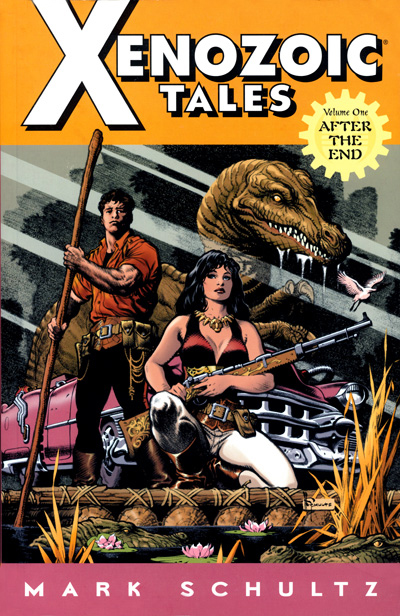
Xenozoic Tales Volume One: After the End. © Mark Schultz. Published by Dark Horse Comics.
Q: Because you are the creator of the series, you have control of what happens, and therefore no major production studio to second-guess your decisions. With the exception of the marketing and distribution help from Kitchen Sink, Marvel, Nelvana, and Dark Horse, you’ve been able to shepherd Xenozoic Tales through its different incarnations the way you want. Were there any drawbacks to overseeing everything and not just writing the story or illustrating the books?
Schultz: Actually, I always had marketing and promotional help with Xenozoic Tales, first with my publisher, Denis Kitchen, filling that role, and then with the agency of Kitchen and Hansen. I have very limited knowledge when it comes to promotion and marketing, as well as distribution, so I have always relied on others for the “business” side of the business. I’ve also been very appreciative of editorial suggestions as well—even though I’ve never had to work with an editor on XT, I feel it helps to have a sounding board—another perspective with different experiences—available. I could never do XT on my own—I’m just the guy who makes the final decisions.
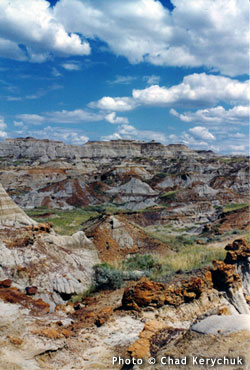 Q: One of the opportunities that I’ve truly enjoyed in life, is participating in palaeontological excavations. One certainly gains deeper respect for the scientists and volunteers that work under challenging field conditions with awkward equipment (ranging from heavy-but-powerful jackhammers to light-but-exacting dental picks) all in the name of research. Have you ever had a chance to join a palaeo/archeological dig and has it helped you with your Xenozoic Tales work?
Q: One of the opportunities that I’ve truly enjoyed in life, is participating in palaeontological excavations. One certainly gains deeper respect for the scientists and volunteers that work under challenging field conditions with awkward equipment (ranging from heavy-but-powerful jackhammers to light-but-exacting dental picks) all in the name of research. Have you ever had a chance to join a palaeo/archeological dig and has it helped you with your Xenozoic Tales work?Schultz: Unfortunately I have never had the opportunity to fulfill that life-long dream. Someday, I hope. I have been lucky enough to visit some fossil-rich sites, such as the Red Deer River Valley, but I’ve yet to find the time to participate. So, in the meantime, I pick the brains of cooperative sorts like our friend Dr. Michael Ryan.
Q: What other kinds of research do you conduct for projects like Xenozoic Tales?
Schultz: Lots of reading--mostly laymen’s scientific magazines and books--visual material of any appropriate kind, travel. Asking questions of the experts. I’m not shy about asking questions.
Your early training must have helped with Xenozoic Tales, so let’s talk a bit about the beginning of your career.
Q: What career training have you received? Was it formal, informal, self-taught, or a little bit of everything?
Schultz: I graduated college with a BFA in Painting from Kutztown State University in Pennsylvania. Unfortunately, the fundamentals of draftsmanship were not stressed like I now believe they should be, and as a result, much of my drawing ability, as it is now, formed through comic book on-the-job training. What I DID learn in college, and what I consider indispensable, was the ability to teach myself—to research and develop on my own accord.
Q: Do you recommend one method over the other for those hoping to follow in your footsteps?
Schultz: I don’t think there is any one right way. The unifying necessity is that you be passionate about what you are doing, immensely self-critical and unafraid to change as needed to become professional, and willing to push yourself harder than everyone else vying for the career you want. Success in the arts does not come to the faint of heart.
Q: Who were your creative influences growing up and why?
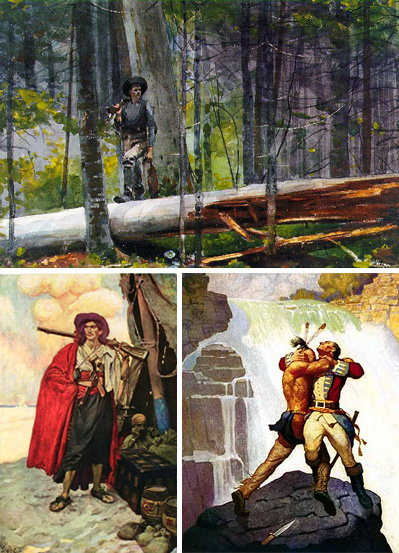
Top: Art by Winslow Homer. Bottom left: Art by Howard Pyle. Bottom right: Art by NC Wyeth.
Schultz: Visually, my work is strongly influenced by a love for classic American illustration. Winslow Homer, Howard Pyle, N.C. Wyeth, Daniel Smith, Dean Cornwell, Herbert Morton Stoops, and Frank Hoban are among the illustrators I’ve closely studied. My principal influences from within the comics field include Hal Foster, Alex Raymond, Roy Crane, Will Eisner, Harvey Kurtzman, Wally Wood, and Al Williamson.
For visuals, as well as storytelling elements, the films of Howard Hawks, Alfred Hitchcock, John Ford, Val Lewton, and many other greats who worked primarily in black and white have had a strong effect on my work. Of course, Cooper and Schoedsack’s King Kong—there will never be a more complex, more visually and thematically rich film. Film and comics are two very different mediums, but if you look past the technical divides, they do share some important storytelling properties.
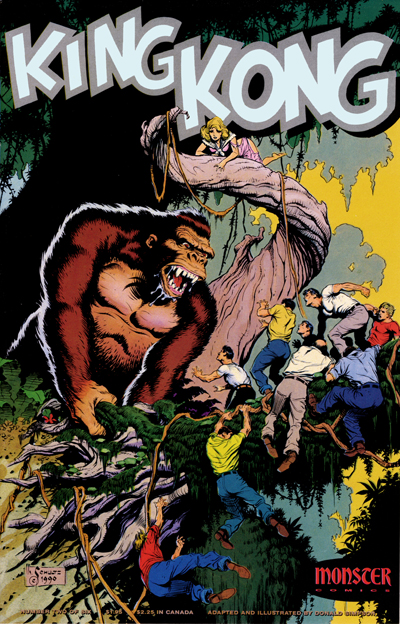
King Kong cover art by Mark Schultz. Issue 2 of 6. © 1990 Mark Schultz and Monster Comics.
For pure storytelling, the writings of Edgar Rice Burrroughs, Robert E. Howard, H.P. Lovecraft and John Steinbeck have meant a lot to me.
Q: Are there any current creative influences you’re learning from or just admire for the work they’re doing?
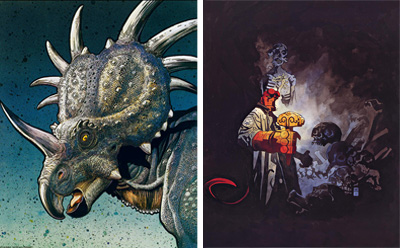
Left: Styracosaur art by William Stout. Right: Hellboy art by Mike Mignola.
Schultz: While I don’t think there are any contemporaries who I’d call influences—Bill Stout being the exception—I admire the work of Gary Gianni, Mike Mignola, Dan Clowes—there are many others…
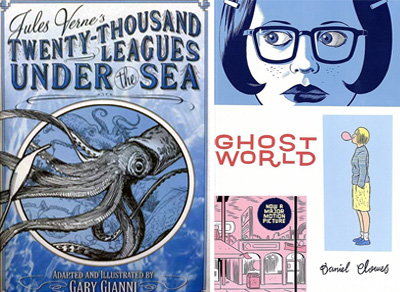
Left: Art by Gary Gianni. Right: Art by Daniel Clowes.
Q: Did you have any ‘big goals’ when you started into your career and do you feel you’ve been successful at achieving them?
Schultz: I had no expectations when I started my comic career. I didn’t even want to get my hopes up that I would be able to make a basic living. Everything that’s come surprises me to certain degree. What success I’ve had amazes me.
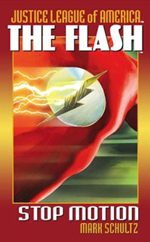 Q: You’ve spent a good part of your early career as an illustrator, yet lately you’ve built up quite the writing resume. Why the shift?
Q: You’ve spent a good part of your early career as an illustrator, yet lately you’ve built up quite the writing resume. Why the shift?Schultz: Actually, I’m shifting back towards illustration now. I like diversity—I like to be able to go back and forth between drawing and writing. Plus, I take advantage of what the marketplace is offering me at the time. I think it's very important, and I keep telling this to students, to become adept with as many different skills as possible—to both take advantage of the marketplace and to maintain as much control over your own properties as possible.
Q: Which do you find easier: illustrating or writing?
Schultz: Nothing’s easy. But I can write faster than I can illustrate.
Q: What artwork/story/project are you most proud of and why?
Schultz: Xenozoic Tales—because it’s my own, start to finish.
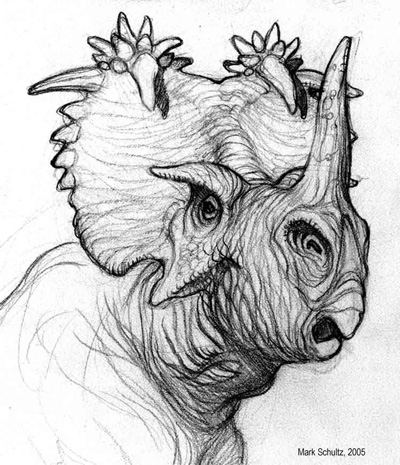
Mark recently completed the above Centrosaurus brinkmani depiction and another illustration for palaeontologist Dr. Michael Ryan.
Art © Mark Schultz from the collection of Dr. Michael Ryan.
-- Continue to Part 2 of the interview! --
1 comment:
Mark left out Frazetta amongst his obvious influences but oh well....
Post a Comment